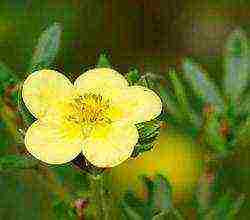Content
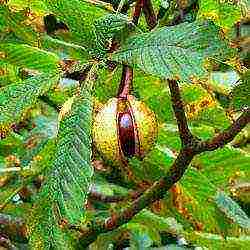 Horse chestnut is a perennial plant (tree or shrub), planting of which in the streets, in parks and individual plots helps to purify the atmospheric air. As studies by Swedish scientists have shown, one specimen of this breed can be cleaned of about 20,000 cubic meters of vehicle exhaust gases. m of air. The article tells about the rules for planting and caring for this wonderful plant in open ground. Breeders have bred various decorative varieties of chestnut, photos of some of them are presented on the site page. The methods of its reproduction and the frequency of fertilization are also highlighted.
Horse chestnut is a perennial plant (tree or shrub), planting of which in the streets, in parks and individual plots helps to purify the atmospheric air. As studies by Swedish scientists have shown, one specimen of this breed can be cleaned of about 20,000 cubic meters of vehicle exhaust gases. m of air. The article tells about the rules for planting and caring for this wonderful plant in open ground. Breeders have bred various decorative varieties of chestnut, photos of some of them are presented on the site page. The methods of its reproduction and the frequency of fertilization are also highlighted.
Varieties and varieties of horse chestnut
Horse chestnut reaches 30 m in height. It has large, palmate leaves and pyramidal racemose inflorescences with flowers that are white-pink in color. As you can see in the photo, ornamental plant varieties can have a varied crown shape - in the form of a ball, column, pyramid, or with branches directed downward, like a weeping willow. Their flowers can have not only white, but also yellow, pink or red color, be simple or double. The leaves of the tree can be green, variegated or golden.

Flowering chestnut
In addition to horse chestnut, the following are most common plant varieties:
- California chestnut... The homeland of this variety is the western states of America. Trees reach 10 meters in height, are characterized by an erect trunk, white-pink flowers are collected in inflorescences, the diameter of which can reach 20 cm.
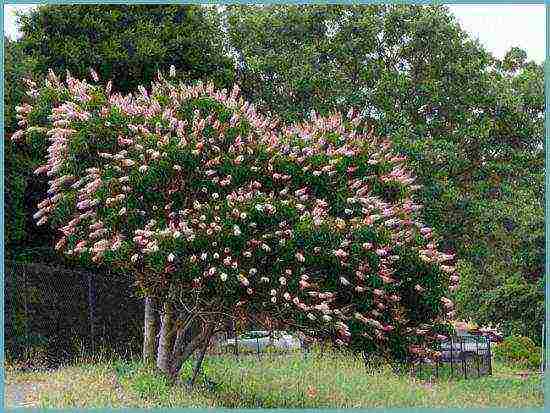
California chestnut
- Chestnut meat-red. This variety is most common on the territory of Ukraine, in the Crimea and in the countries located in the south of the Baltic States. The height of the trees can be from 15 to 25 m, the fruits are round in shape, the flowers are dark pink or dark red, the leaves are dark green, leathery, and do not tolerate drought well.
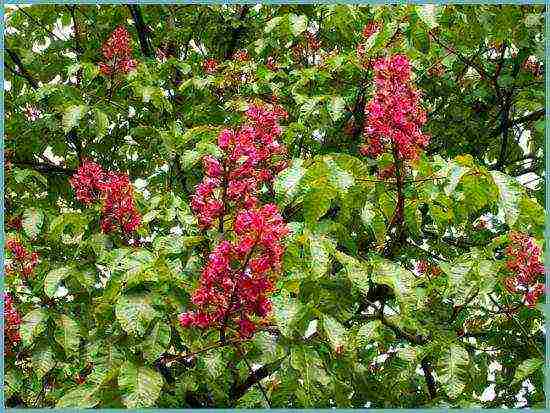
Chestnut meat-red
- The chestnut is yellow. Natural place of growth - the eastern states of America. It can reach 30 m in height, the crown has a pyramidal shape, the leaves are finely toothed wedge-shaped, they have a yellowish tint on the underside. This variety is the most cold-resistant of all types of chestnut, its flowering begins 15-20 days later than ordinary chestnut.
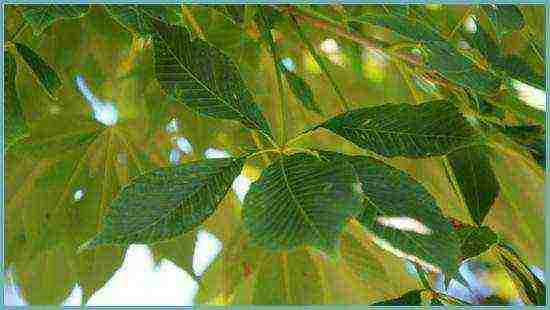
Chestnut yellow
- Small-flowered chestnut. It is a shrub reaching 5 m in height, creating dense thickets. Grows in the southeastern United States. Its leaves consist of 5-7 leaves, the underside of which is pubescent and has a grayish tint, the flowers are pink-white in color.
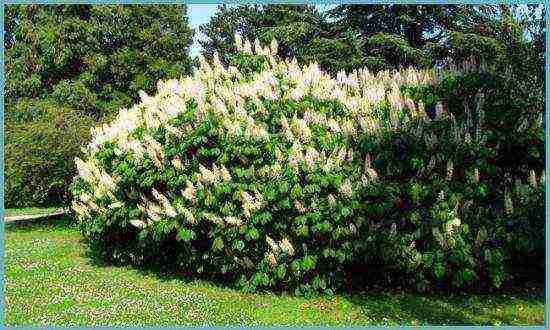
Small-flowered chestnut
- Chestnut red (pavia)... It is found in the eastern states of the United States in the form of a tree, the maximum height of which is 12 m, or a shrub, no more than 6 m in height. The flowers are bright red, the surface of the fruit is smooth, without bristles.
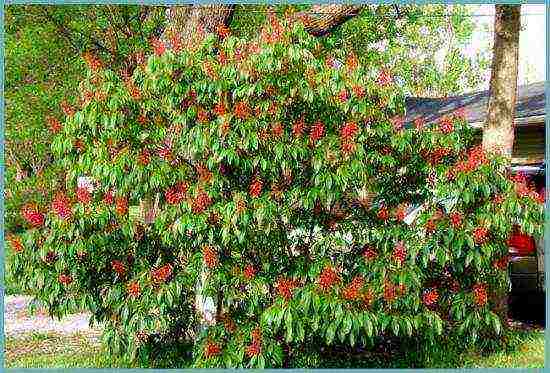
Chestnut red
- Japanese chestnut. Reaches 30 m, has a straight narrow trunk, from which spreading branches extend widely. Stipules of this species can be quite long, sometimes reaching 16 cm, inflorescences are yellowish-white, ripening fruits are pear-shaped.

Japanese chestnut
Planting seedlings
For planting horse chestnut seedlings, areas with loamy soil well lit by the sun are most suitable. The distance from the future tree to other objects - buildings or plants - should be 5 m. This will allow its crown to develop well. Chestnut roots are quite sensitive to stagnation or lack of water in the soil. You can improve the quality of clay soil by adding sand, sandy - by adding humus or mature compost. For growing horse chestnut, soil with an acidity of not more than 7.5 is suitable; you can reduce the acidity by adding quicklime.
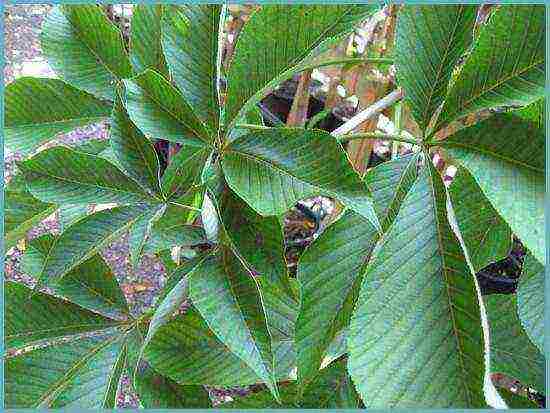
When planting chestnuts, leave enough space for the crop to grow
Planting sequence:
- A hole is dug with sides of 50-60 cm.
- If the soil is clayey, a layer of sand or gravel 10-15 cm thick is poured onto the bottom, which will help remove excess water.
- The seedling is installed in the pit so that after watering and subsidence of the earth, the root collar is at the level of the pit surface.
- The voids between the roots of the seedling and the walls of the pit are filled with a pre-prepared earthen substrate, including slaked lime (if the soil is acidic), rotted manure and dolomite flour.
- Abundant watering of the plant, installation of a support, which will provide support for a young tree in strong gusts of wind.
Advice. In order for the seedlings to take root well, it is necessary to monitor the soil moisture during the first week after planting, preventing it from drying out.
Tree care
After planting, during the first years, horse chestnut seedlings require the following care:
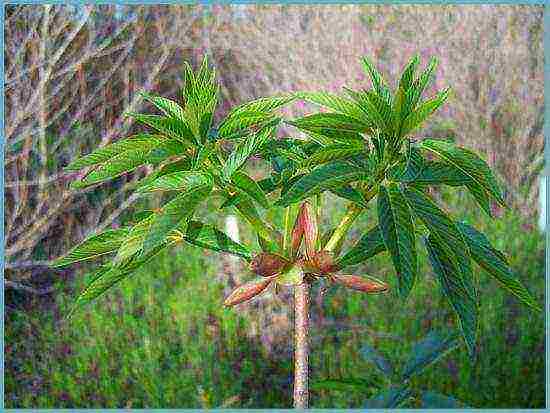
Horse chestnut seedling
- periodic feeding;
- regular watering in dry weather;
- loosening the soil, followed by mulching its surface with peat, chips or sawdust to improve air flow to the roots and prevent the growth of weeds;
- decorative varieties with a beautiful crown shape need annual pruning; in other varieties, dried or damaged branches are removed.
Advice. To protect the roots of young seedlings from severe frosts for the winter, the surface of the trunk circles should be insulated with a layer of fallen leaves. Wrapping with one or two layers of burlap will help to protect the trunk from the appearance of frost cracks. If the trunk is damaged by frost, it is treated with an antiseptic and a layer of garden varnish is applied.
Using fertilizers to feed trees
Horse chestnut is fed in spring and autumn. In the spring, take 1 kg of mullein, 25 g of ammonium nitrate and 15 g of urea on a bucket of water. For top dressing at the beginning of autumn, it is enough to dissolve 15 g of nitroammophoska in 10 liters. A good fertilizer is humus or compost, which can be applied in a layer 10 cm thick on the soil under the tree before digging the soil in autumn.
Breeding horse chestnut
The easiest way to propagate horse chestnut is by seeds, less popular is the planting of root suckers, rooting of cuttings or cuttings. The fruits of the plant are stratified before planting.

Horse chestnut is propagated by seeds
To do this, you need to prepare a wooden box, fill it with moistened sand. The chestnuts that have fallen from the tree are placed in warm water for several days, changing it daily, and then placed in a box of sand. The box is placed in a cellar or other cool place. After frosts in May, with warming, the fruits should be planted in a prepared place to a depth of 10 cm.
Advice. Shortening the taproot of a 2 year old seedling by one third will result in the development of additional lateral roots and the growth of a lush, spreading crown.
Horse chestnut pests and diseases they cause
The main pests of chestnut:
- Wood mite - for prevention, periodic (every 2 weeks) seasonal treatment of plantings with a solution of phytover or karbofos is recommended.
- Powdery mildew - the disease is manifested by the formation of a grayish bloom or brown spots on the foliage.Prevention is feeding plants with mineral fertilizers containing phosphorus or nitrogen. Fungicides are used to destroy the pathogen.
- Chestnut moth - if it affects trees, it is recommended to spray them with an environmentally friendly chemical agent Lufox 105 EC.
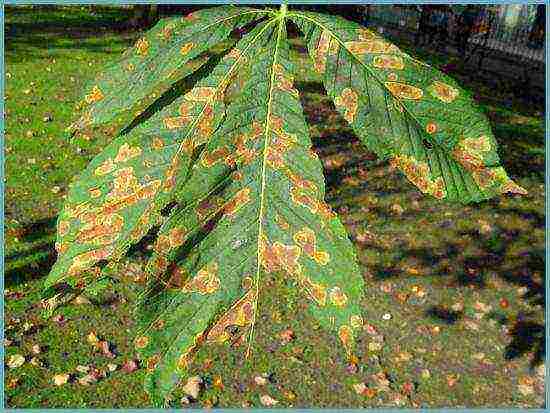
Leaves infested with chestnut moth
- Brown spot - caused by fungi, prevention of the disease consists in spraying the leaves with a 1% solution of Bordeaux mixture.
By planting a chestnut near your home, you can improve the city's atmosphere, which is unhealthy, saturated with exhaust gases, and give a beautiful look to your yard and street. From the collected inflorescences and bark of the tree, you can prepare medicinal products for external use. The shade of the tree will protect well from the summer heat, and the powerful crown will protect against gusts of wind.
Horse chestnut: video
Horse chestnut flowering: photo
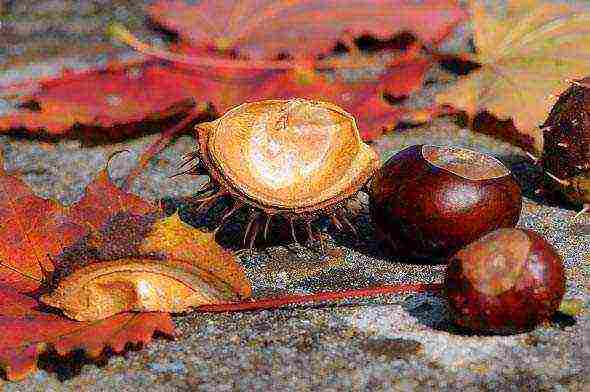
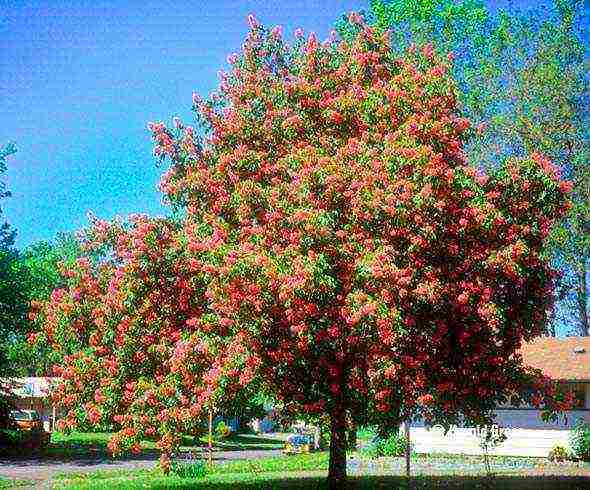
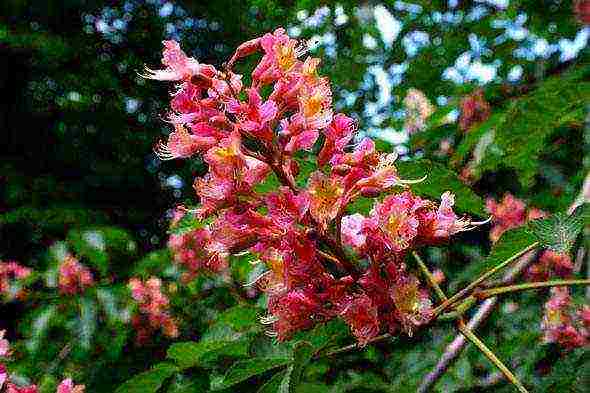



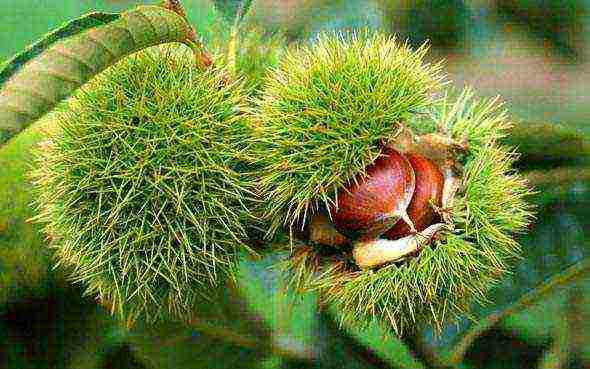

Chestnut blooms for two weeks
Chestnut is a beautiful sprawling tree culture with a height of 20-25 m.
Within two weeks, it pleases with its flowering, and by October it gives fruits that have many useful properties. The tree is quite unpretentious and does not require complex maintenance.
Landing
Seat selection
The chestnut has a wide crown. It prefers to grow in lighted places, tolerates shade well, but blooms poorly without exposure to direct sunlight.
For normal development, there should not be any buildings or plants within a radius of 5 m from the chestnut.
Timing
Saplings are planted in early spring or November, and sprouted nuts are planted in early May or left in the ground in autumn.
Soil preparation
Chestnut has a shallow root system.
So that the roots do not rot and the water does not stagnate, the tree is planted in moderately moist neutral or slightly acidic loose soils with good drainage. Black soil or loamy substrate with an admixture of lime and sand is suitable. A little clay can be added to sandy soil.
Features of planting seedlings

When growing chestnuts within a radius of 5 meters from the seedling, there should be no plants
Dig a cube-shaped hole, 50-60 cm deep and wide.
At the bottom, place a layer of sand mixed with crushed stone, 30 cm thick. This will provide drainage.
If necessary, add humus to the soil mixture, with increased acidity - dolomite flour.
When installing a seedling in a hole, make sure that the root collar is at the level of the soil.
To avoid exposing the trunk, make the planting hole 10 cm higher.After planting, pour the tree with plenty of water (3-4 buckets).
Install supports around the seedling on four sides - this will protect the fragile tree from gusty winds.
Reproduction
Chestnut is propagated by cuttings, layering, root suckers and seeds. The latter method is used more often; it is not difficult to grow a tree from a nut.
Features of seed reproduction
Fully ripe fruits are suitable for germination. Use whole and undamaged nuts that have fallen to the ground.
Seeds germinate only after stratification, which can be carried out under natural conditions - at the end of autumn, plant the harvested fruits in open ground and warm them on top with dry leaves. In the spring, many seeds will sprout.
With this method of reproduction, there is a risk of damage to the nut by rodents.
For artificial stratification, the fetus is placed in a tightly closed container filled with wet sand in a cold place for a period of two to five months.
Five days before planting, the fruits are soaked in warm water, which is changed from time to time. This softens the hard shell of the nut and promotes further germination. Treated chestnuts are planted in the ground to a depth of 8-10 cm.
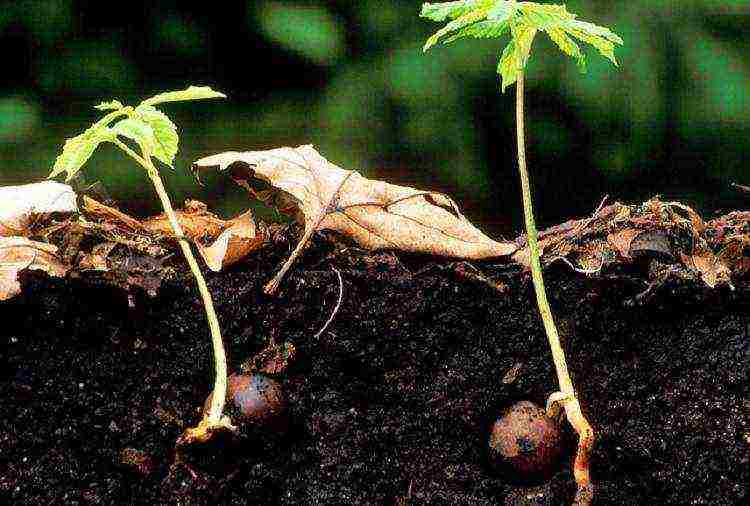
Chestnuts are grown from walnuts in late autumn
At the end of winter, you can plant chestnuts in pots, and in May, plant them in open ground, pinning the taproot, which will allow the plant to develop a strong root system.
In the first 3 years, and in colder regions - 5 years, the tree is grown in greenhouses, exposing it to the street for the summer.
You can find out about the species of fast-growing trees here.
And you can find out how to properly care for thuja by following this link
Care
Summer care consists in weeding, shallow loosening of the earth, top dressing.
Young individuals need regular watering, adults only in the hot dry season. Water in the evening.
Top dressing
The tree is fertilized in early spring with such a solution: for 10 liters of water - 1 kg of mullein and 15 g of urea.
In autumn - 15 g of nitroammophoska are mixed into the same volume of water. For fertilization, the trunk circle is also mulched with a layer of 10 cm of wood chips, peat or peat compost.
Pruning
The chestnut is shaped like a standard tree with a main trunk. For drooping branches to look better, the stem should be at least 2-3 meters in height.
A central stem with evenly spaced branches is formed from a main shoot, which is supported as long as possible.
When the crown is formed, the tree needs little or no pruning. In early spring, damaged and dry branches are cut.
In the summer, if the crown is overgrown, young shoots are removed. All summer cuts are covered with garden var.
Winter care, preparation for winter
The tree is frost resistant.
Only young trees need additional protection in the first 2-3 years after planting. Their trunks are mulched with a layer of fallen leaves 20 cm thick, and the trunks are insulated with burlap. In case of cracks in the bark due to severe frosts, an antiseptic is applied to the damaged area and covered with garden varnish.
As it matures, the winter hardiness of the tree increases.
Pest and disease control
Most often, chestnut is attacked by chestnut (or miner) moth, tree mite and powdery mildew.

Chestnut moth primarily damages tree foliage
When attacking moths diseased chestnuts shed their leaves in the middle of summer, and new foliage and flowers grow in autumn. As a result, the tree is very weak and may not survive the winter.
In the fight against this pest, special chemicals help. For example, the drug Lufox 105 EC, which destroys the insect at all stages of development.
Leaves that have fallen as a result of illness during the summer and autumn are collected and burned, since the moth lays the larvae in them.
Often the chestnut is affected by a fungal disease - powdery mildew.
White-gray bloom or rusty-brown spots form on the upper side of the leaves, the leaves turn yellow and quickly fall off. The disease is treated with fungicides. They also treat the tree for preventive purposes, and also feed them with nitrogen or phosphorus fertilizers.
To prevent the appearance wood mite the chestnut is processed with karbofos or fitover every two weeks.
Want to plant heather in your garden? Find out how to do it right in this article.
Varieties and types of shrubs for summer cottages - selection criteria and rules.
Read about the varieties of hydrangea paniculata at the link
Varieties
For temperate climates, varieties such as American chestnut, European and horse are most suitable. They are resistant to subzero temperatures and are quite unpretentious.
American chestnut, aka toothed, has a brown bark, yellowish shoots, on which there are many long lentils.
The leaves are large with sharp teeth. Edible nuts, covered with fluff, taste sweet. The tree develops quickly, but requires a lot of sunlight.
Sowing European chestnut has brown bark and ribbed reddish or olive shoots. The branches are covered with glandular hairs.
Leaves are oblong with crescent teeth, covered with grayish down below.
Male dense spikelets-inflorescences reach 35 cm in length, female ones - short and knocked down. The fruits are edible, covered with a prickly shell.
Horse the chestnut is very decorative.It has a spreading dark crown and conical inflorescences.
Leaves with long petioles, five- or seven-fingered.
The fruits are inedible, round, hidden in thorny pericarp. This variety prefers to grow in loamy soils with an admixture of lime. Horse chestnut is a great natural air filter.
Photos of chestnut varieties can be viewed in the gallery:
Application in landscape design
As part of the overall picture, the chestnut fits perfectly into the image of a parkland among firs, pines, birches and acacias. Beautiful decorative alleys are planted from a group of chestnuts.
In a garden and dacha design, the chestnut looks best as a single planting in the middle of the lawn.
Growing chestnuts is pretty easy. With proper care, a few years after planting, you will be delighted by a beautiful majestic tree that will ennoble the site, hide from the sun in its shade on hot days and bring aesthetic pleasure.
Jul 14, 2015Elena Tymoshchuk
Chestnut - a tree with a thick trunk, dense foliage and a gorgeous crown. It can reach a height of 30 meters. It prefers the most illuminated places, but it can also grow in the shade. It is considered a beautiful park plant. Its flowering begins in May and lasts about a month. Then the fruits appear. Differs in resistance to diseases and various pests.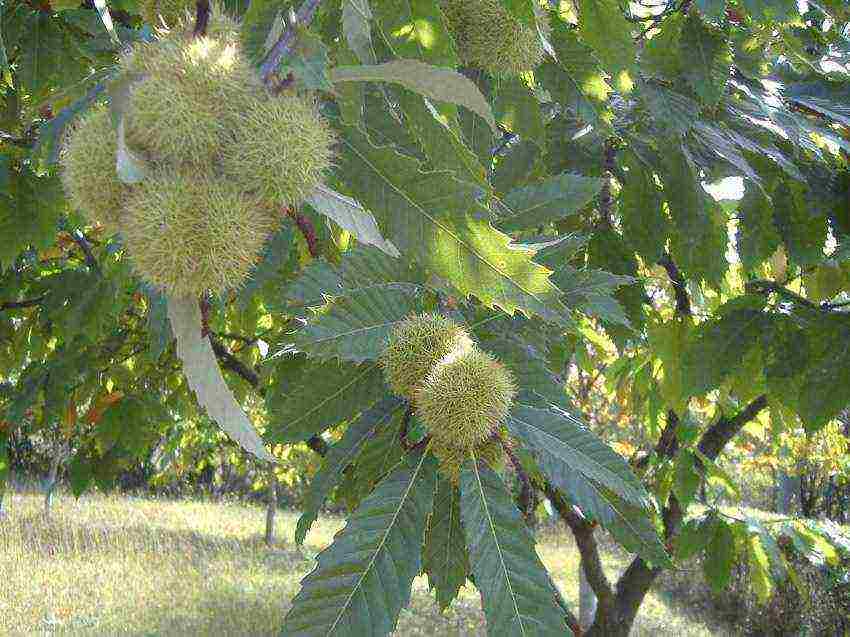
Landing place
For planting a plant, the place is prepared in advance. It requires space and maximum illumination. It is desirable that its distance from various buildings and plants be at least 5 meters. The earth must contain nutrients.
Taking into account the large horse system of an adult tree, the planting pit should be at least half a meter in circumference. Fertilizers or humus can be added to the soil to enrich it with nutrients. Preparation for planting begins in the fall, and the planting itself is carried out in the spring.
When and how to plant chestnuts outdoors?
There are 2 planting methods:
- Saplings... For this, two-year-old shoots are used. Planting process:
- In the ground, create a hole in advance with a size of at least half a meter, add special fertilizers to it;
- At the bottom of each hole, lay out a drainage of about 20 cm;
- Cover the drainage layer with prepared soil and pour abundantly with water;
- Plant a seedling;
- Fill up the earth and compact it well.
At the end of planting, a mound should turn out to be about 20 cm in height. It is advisable to fix the planted seedlings at a support to protect them from strong winds.
- The fruits... This method is very popular with gardeners. Planting process:
- Ripe autumn fruits should be stored in a cool place until spring in a container with sand;
- Before planting in the soil, the nuts should be soaked in water for 5 days. This is necessary for the formation of the embryo;
- Prepare a landing site. The depth of the fossa should not exceed 5 cm;
- Plant the fruits, cover them with earth and water.
The best time for planting is spring. Plants planted at this time of year are fast growing and of good quality.
Chestnut care 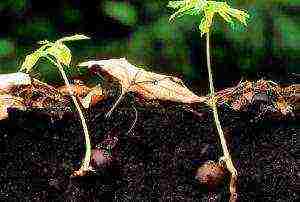 Growing chestnuts from walnuts
Growing chestnuts from walnuts
Caring for a tree is easy. But certain knowledge will definitely come in handy:
- Seedlings must be tied to a support to protect them from adverse weather conditions;
- Young trees need to be watered abundantly to strengthen the roots;
- It is necessary to loosen the soil near the plant every season;
- Dried branches are removed annually in the spring;
- In adult plants, you need to form a crown by cutting off the branches.
The soil in which the chestnut grows must be fertilized. To do this, use compost or manure. You can prepare a special solution: add 20 grams of nitroammofosk to 10 liters of water.
Diseases and pests
The chestnut tree is considered the least susceptible to various pests and diseases. But, nevertheless, several diseases and pests can be distinguished that have a detrimental effect on the plant.
Foliage diseases
-
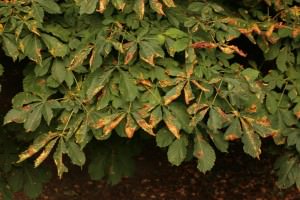 Ocher five
Ocher five
Powdery mildew... This disease is characterized by the appearance on the leaves of a white, inconspicuous bloom. Over time, it becomes denser and covers the entire surface of the leaf. Trees of different ages are susceptible to this disease.
- Brown spot... On the leaves, brown spots of an uneven shape appear on both sides. They grow rapidly over the entire surface of the leaf;
- Ocher spot... It is characterized by the appearance of spots of orange spots up to two centimeters in size. On the upper side, the spots have small black dots.
Trunk diseases Pests
- Pests in the roots... They can be beetles and larvae of May beetlethat damage the leaves and roots of the tree;
- Sucking insects... They use the juice of shoots and leaves for food. These insects include: thrips, aphids... Maximum damage to a tree can be caused by scabbard... As a result of its effect on the chestnut, the number of leaves decreases, the branches dry out;
- Leaf-eating insects... They are characterized by the consumption of plant foliage.
How to deal with diseases and pests?
For pest control and treatment of various diseases, special means are used that are suitable for combating certain diseases. In order to identify the problem in a timely manner, it is necessary to constantly and carefully monitor the tree.
The right care in the right conditions can help reduce the risk of disease. If dried branches appear on the plant, they must be removed immediately.
Types of chestnuts
All types of this plant can be divided into 2 large groups:
- Horse chestnut... A common tree that can often be seen in parks and gardens in the city. It has a huge crown and large leaves. Its fruit is shaped like a round box with sharp thorns, inside which is a seed;
- Noble chestnut... This group includes trees with edible fruits, which contain from 2 to 4 seeds. It is very difficult to grow such trees in Russia, since a suitable subtropical climate is necessary for their growth.
There are about 30 types of chestnut in total. There are several of them, the fruits of which can be eaten:
- Japanese chestnut. His homeland is Japan, China. The peculiarity of this species is that it grows quickly and its first fruits appear as early as 3 years old. The size of the fruits is the largest among all types of chestnuts - up to 100 grams by weight and up to 7 seconds in diameter;
- Chinese chestnut. Reaches a height of 16 m, has spreading branches and medium-sized leaves. Flowers of this species can be of different shades, and the fruits have an unsurpassed taste and are often used for cooking;
- European (sowing) chestnut. A tall tree, has a crown of a neat regular shape, yellow inflorescences. Its life span can reach 500 years.
Chestnut is a beautiful chic tree. It is very important to know all its features and care rules. Then it will delight more than one generation with its appearance.
The beautiful sight of a blooming chestnut fascinates many people. Folk omens say that the tree has healing powers and brings good luck. If you need to improve the energy of your home and decorate your garden plot, learn how to plant a chestnut and make it grow and develop quickly.
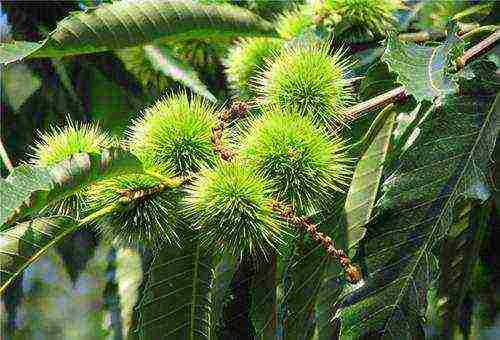
What are chestnuts
In our country, you can find two types of chestnuts. The first variety is ubiquitous. This is a horse chestnut. It is easy to grow it near the house, in gardens, squares, along roadsides. The tree has a wide crown, a massive trunk and large leaves, somewhat reminiscent of a hand in their outlines. In May, the branches of the tree are covered with large flowers, similar to candles, from which green round fruits with thorns emerge. In autumn, the green balls fall off, crack into three parts, freeing the brown shiny core.
Those who believe in omens collect the horse chestnut, because, according to popular belief, its fruits bring good luck.So that fortune does not leave, you need to put three nuts in your pocket and carry them constantly with you.
The second variety is the noble chestnut from the beech family. In central Russia, it is difficult to grow it, because the tree loves a humid climate and warmth. It has thin narrow leaves, the fruits are in round spiny capsules. In autumn, they open, and 1–4 small nuts fall out of them, which have a sweetish delicate taste.
If you believe in ancient signs, it is these fruits that are able to attract money. You only need to carry 2 nuts in a bag next to your wallet and never leave them at home.

Growing from seeds in the garden
Planting a chestnut tree near the house is a responsible business, despite the fact that it does not need special care. Many gardeners are interested in how to plant walnut chestnuts.
- In the fall, pick ripe large fruits under the tree.
- For planting at the end of October, you need to prepare the seeds in advance. Pour them into a deep container with coarse sand, put them in the refrigerator for two weeks, or lower them into the basement.
- After such a stratification procedure, you can start planting a nut in the country.
If it is planned to deepen the seeds into the ground in the spring, then the chestnuts need to be prepared in a different way. When the tree has removed all of its fruit, harvest the best seeds and store them in the basement. In the spring, 5 days before planting near the house, place the chestnuts in a bowl and cover with warm water. Pour the cooled liquid several times a day and add warm one. Thanks to this, the shell of the nut will become soft and the embryo inside it will swell.
In the spring, dig holes 20 cm deep and place the nuts in them. Sprinkle with earth and water thoroughly. A young sprout will quickly appear above the soil surface, and after a few years it can be transplanted to a permanent place.
Advice
Collected chestnuts in the fall can be used for a talisman. Spread out 2 fruits on each cupboard and open shelves in the house. Ancient omens say that this is how you can attract happiness.
Horse chestnut is undemanding, it does not need regular complex care. It grows beautifully in a flowerpot on a windowsill.
How to plant a chestnut so you can see the shoots quickly?
- To do this, in the fall, after stratification of the seeds, prepare a pot, fill it with a thin layer of drainage, potting soil from the store and dig in the chestnut at a depth of 5 cm.
- Water thoroughly and place on the sunny side of the house.
- Such care will ensure germination, and in the spring the tree can be transplanted. Find a spot for him near a fence or on a wide lawn.
Some folk signs do not recommend planting a horse chestnut from a walnut on your own. Ancient beliefs say that a tree planted in this way takes health from its owner. Believe in omens or not, everyone decides for himself. If you wish, it is not difficult to grow a chestnut near the house with seedlings.

Planting seedlings
It is easy to get a young two-year-old tree in a special nursery. Rooting of a seedling is allowed in the spring, at the beginning of May, or in the fall, when the leaves fall from the trees.
- Choose a suitable site in the country. It is important that the distance between the trees is at least 3 meters, otherwise the chestnut will not be able to fully develop, despite proper care.
- Dig holes 50 cm wide and deep. Connect the earth from them with humus and river sand in a ratio of 2: 1: 1. Stir and add 500 g of slaked lime and dolomite flour each. This soil is ideal for chestnuts.
- Pour a thick layer of expanded clay on the bottom of the pit. You can use pebbles or broken bricks instead. Sprinkle with prepared soil and put 200 g of nitrogen-potassium fertilizer on top.
- Fill the hole with 2 buckets of water, place the seedling and cover it with earth, gently tamping it down with your hands.
- Water the tree again and sprinkle lightly. The mound will gradually settle under the influence of the rains.
- To prevent the fragile branches of the seedling from being damaged by the wind, install a support near it and tie it up.
Now you know how to plant a chestnut near your house.This is not difficult. The tree can be grown in any soil, but it will be better to bloom in loamy black soil. This is a frost-resistant plant, the trunk of which must be covered only in very severe cold.

How to care
Caring for a chestnut tree in the country does not require special skills. Loosen the soil in time, get rid of weeds. It's enough.
Moderate watering will help to grow the tree correctly. If the summer is very hot, water it once a month with 7-10 liters of water. Above all, don't moisturize too much. The chestnut has a powerful root system that penetrates deep into the soil and supplies the plant with water.
Advice
In the spring, it is advisable to trim the upper shoots by a quarter of the length. From this procedure, the crown will form thick and lush.
When the horse chestnut blooms, rest more in the shade of the tree. If you believe in the signs, a blossoming flower that has fallen from a branch onto a person guarantees good luck and happiness in the current year.
To grow chestnuts, you need fertilizer. Care will not be complete without it. Top dressing is done in early spring. For her you will need:
- 15 liters of water;
- 20 g of ammonium nitrate;
- 1 kg of manure;
- 15 g of urea;
- 25g of nitrogen-potassium-phosphorus fertilizer.
The components will need to be mixed together and moisten the soil with a solution.

Diseases and pests
Horse chestnut is hardy and rarely gets sick. But still there are a number of diseases that the tree is susceptible to.
- Powdery mildew. This is a fungal disease in which a white bloom appears on the leaves. They dry, turn black and fall off.
- Red-brown and brown spots. The symptoms of the diseases are similar. Leaves deteriorate, covered with black dots and spots.
To prevent the spread of the disease, collect fallen leaves and burn. Remove affected branches in time, heal the wounds that appear on the trunk, and avoid waterlogging. If the disease persists, spray the crown with fungicides according to the instructions.
The chestnut moth does a lot of damage to the tree. It infects the leaves, and if the parasite is not destroyed, the plant may die over time.
The insect is very tenacious, conventional pest control methods do not help. The moth is taken inside the sheet plate, which protects it from the effects of chemicals.
Advice
Good results are shown by treatment with systemic insecticides. You will need a powerful sprayer to wet the crown. Remember to wear gloves and a respirator to protect your hands and lungs.
You can completely rid the tree of moths with special injections. This new development is quite expensive and not everyone can afford it. But if you have a lot of chestnuts growing in front of your house, it is better to invite a specialist so that he correctly gives the plants an injection of a systemic insecticide.
So, the chestnut is definitely worth growing near the house - according to ancient beliefs, it protects people, absorbs all negative energy. From this, headaches disappear in households, mood improves and strength for new achievements appears.
Chestnut is useful for young girls. In the old days, under a flowering tree, they made cherished wishes. Signs claim that the voiced dreams have always come true.
